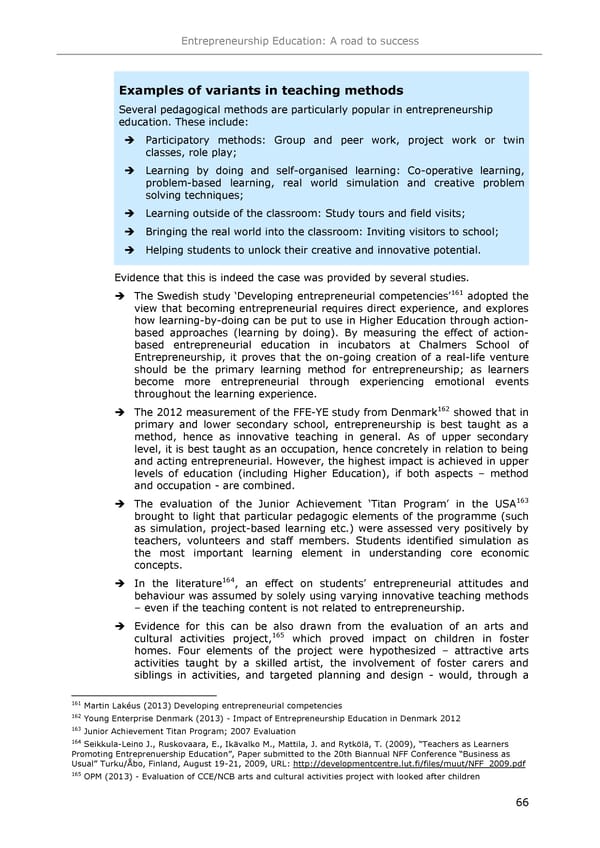Entrepreneurship Education: A road to success Examples of variants in teaching methods Several pedagogical methods are particularly popular in entrepreneurship education. These include: Participatory methods: Group and peer work, project work or twin classes, role play; Learning by doing and self-organised learning: Co-operative learning, problem-based learning, real world simulation and creative problem solving techniques; Learning outside of the classroom: Study tours and field visits; Bringing the real world into the classroom: Inviting visitors to school; Helping students to unlock their creative and innovative potential. Evidence that this is indeed the case was provided by several studies. The Swedish study 8Developing entrepreneurial competencies9161 adopted the view that becoming entrepreneurial requires direct experience, and explores how learning-by-doing can be put to use in Higher Education through action- based approaches (learning by doing). By measuring the effect of action- based entrepreneurial education in incubators at Chalmers School of Entrepreneurship, it proves that the on-going creation of a real-life venture should be the primary learning method for entrepreneurship; as learners become more entrepreneurial through experiencing emotional events throughout the learning experience. The 2012 measurement of the FFE-YE study from Denmark162 showed that in primary and lower secondary school, entrepreneurship is best taught as a method, hence as innovative teaching in general. As of upper secondary level, it is best taught as an occupation, hence concretely in relation to being and acting entrepreneurial. However, the highest impact is achieved in upper levels of education (including Higher Education), if both aspects 3 method and occupation - are combined. The evaluation of the Junior Achievement 8Titan Program9 in the USA163 brought to light that particular pedagogic elements of the programme (such as simulation, project-based learning etc.) were assessed very positively by teachers, volunteers and staff members. Students identified simulation as the most important learning element in understanding core economic concepts. In the literature164, an effect on students9 entrepreneurial attitudes and behaviour was assumed by solely using varying innovative teaching methods 3 even if the teaching content is not related to entrepreneurship. Evidence for this can be also drawn from the evaluation of an arts and 165 cultural activities project, which proved impact on children in foster homes. Four elements of the project were hypothesized 3 attractive arts activities taught by a skilled artist, the involvement of foster carers and siblings in activities, and targeted planning and design - would, through a 161 Martin Lakéus (2013) Developing entrepreneurial competencies 162 Young Enterprise Denmark (2013) - Impact of Entrepreneurship Education in Denmark 2012 163 Junior Achievement Titan Program; 2007 Evaluation 164 Seikkula-Leino J., Ruskovaara, E., Ikävalko M., Mattila, J. and Rytkölä, T. (2009),
 Entrepreneurship Education Page 69 Page 71
Entrepreneurship Education Page 69 Page 71